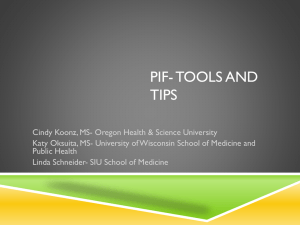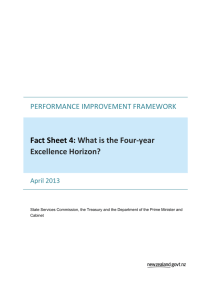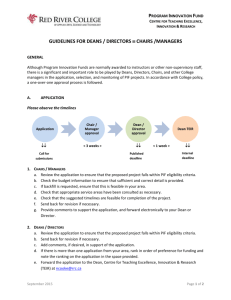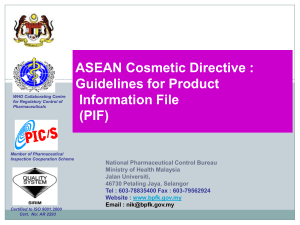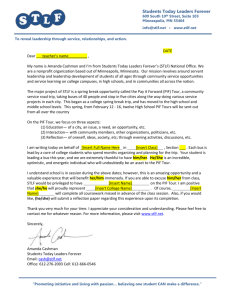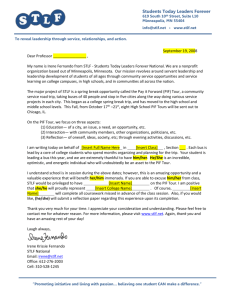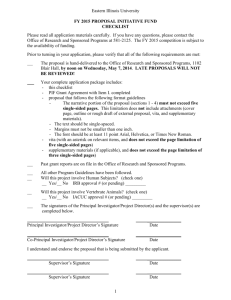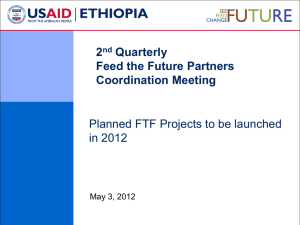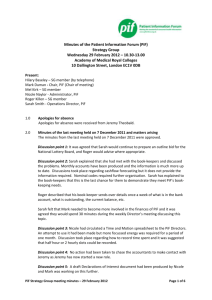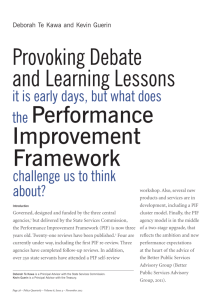Fact Sheet 1: Introducing the Performance Improvement Framework
advertisement
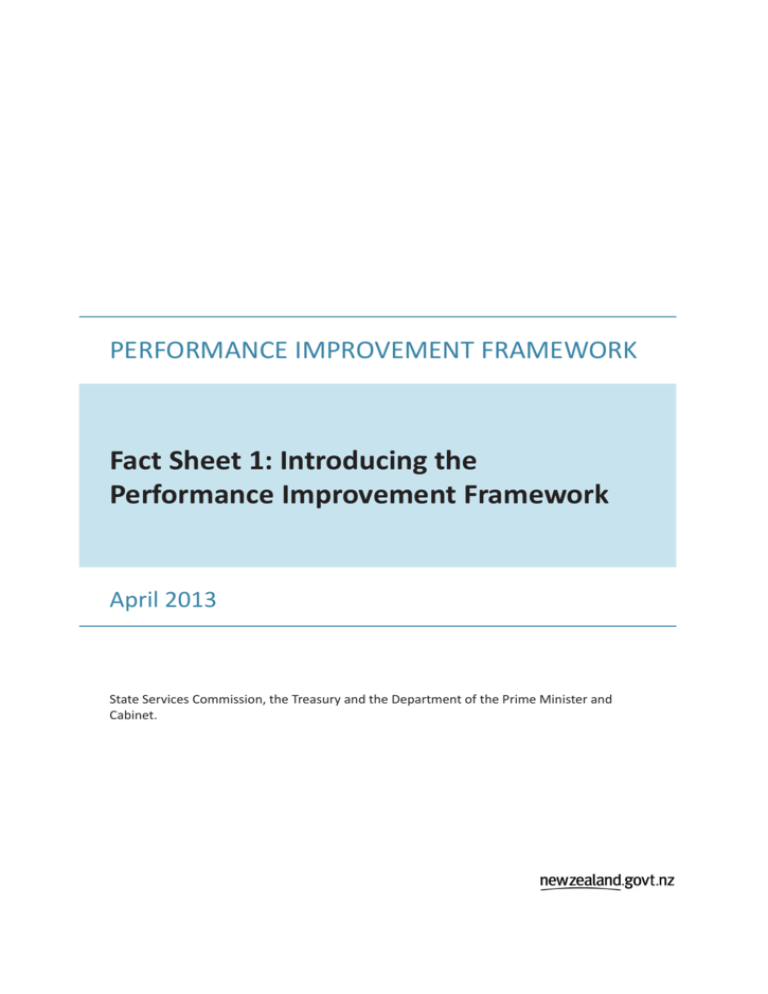
PERFORMANCE IMPROVEMENT FRAMEWORK Fact Sheet 1: Introducing the Performance Improvement Framework April 2013 State Services Commission, the Treasury and the Department of the Prime Minister and Cabinet. FACT SHEET 1: INTRODUCING THE PERFORMANCE IMPROVEMENT FRAMEWORK – APRIL 2013 1 FACT SHEET 1: INTRODUCING THE PERFORMANCE IMPROVEMENT FRAMEWORK – APRIL 2013 2 What is the Performance Improvement Framework? Performance Improvement Framework (PIF) is a term used to refer to a review, as well as an organisational improvement model. In essence, it is a review of an agency’s fitness-forpurpose today and for the future. Using the PIF Agency Model, a PIF Review looks at the current state of an agency and how well placed it is to deal with the issues that confront it in the medium-term future. It then proposes areas where the agency needs to do the most work to make itself fit-for-purpose and fit-for-the-future. The Agency Model has two major components: Results and Organisational Management. The Results component has two Critical Areas: Delivery of Government Priorities and Delivery of Core Business. Organisational Management has four Critical Areas each of which are supported by a number of Elements. The Elements are designed to provide a greater level of detail and focus. The following diagram summarises the PIF Agency Model at a high level. Delivery of Government Priorities How well is the agency responding to government priorities? Delivery of Core Business How effectively is the agency delivering each core business area? How efficiently is the agency delivering each core business area? How well does the agency’s regulatory work achieve its required impact? Organisational Management How well is the agency positioned to deliver now and in the future? Leadership, Direction and Delivery • Purpose, Vision and Strategy • Leadership and Governance • Values, Behaviour and Culture • Structure, Roles and Responsibilities • Review External Relationships • Engagement with the Minister(s) • Sector Contribution • Collaboration and Partnership with Stakeholders • Experiences of the Public People Development • Leadership and Workforce Development • Management of People Performance • Engagement with Staff FACT SHEET 1: INTRODUCING THE PERFORMANCE IMPROVEMENT FRAMEWORK – APRIL 2013 Financial and Resource Management • Asset Management • Information Management • Improving Efficiency and Effectiveness • Financial Management • Risk Management 1 The Agency Model is further defined using 28 Lead Questions. The following diagram details the Lead Questions. Results Critical Area Lead Questions Government Priorities 1. How well is the agency responding to government priorities? Core Business 2. How effectively is the agency delivering each core business area? 3. How efficiently is the agency delivering each core business area? 4. How well does the agency’s regulatory work achieve its required impact? Organisational Management Critical Area Leadership, Direction and Delivery External Relationships People Development Element Lead Questions Purpose, Vision and Strategy 5. How well has the agency articulated its purpose, vision and strategy to its staff and stakeholders? 6. How well does the agency consider and plan for possible changes in its purpose or role in the foreseeable future? Leadership and Governance 7. How well does the senior team provide collective leadership and direction to the agency? 8. How well does the Board lead the Crown entity? (For Crown entities only) Values, Behaviour and Culture 9. How well does the agency develop and promote the organisational values, behaviours and culture it needs to support its strategic direction? Structure, Roles and Responsibilities 10. How well does the agency ensure that its organisational planning, systems, structures and practices support delivery of government priorities and core business? 11. How well does the agency ensure that it has clear roles, responsibilities and accountabilities throughout the agency and sector? Review 12. How well does the agency monitor, measure, and review its policies, programmes and services to make sure that it is delivering its intended results? Engagement with the Minister(s) 13. How well does the agency provide advice and services to its Minister(s)? Sector Contribution 14. How well does the agency provide leadership to, and/or support the leadership of other agencies in the sector? Collaboration and Partnerships with Stakeholders 15. How well does the agency generate common ownership and genuine collaboration on strategy and service delivery with stakeholders and the public? Experiences of the Public 16. How well does the agency meet the public’s expectations of service delivery quality and trust? Leadership and Workforce Development 17. How well does the agency develop its workforce (including its leadership)? 18. How well does the agency anticipate and respond to future capability requirements? Management of People Performance 19. How well does the agency encourage high performance and continuous improvement among its workforce? 20. How well does the agency deal with poor or inadequate performance? Engagement with Staff 21. How well does the agency manage its employee relations? 22. How well does the agency develop and maintain a diverse, highly committed and engaged workforce? Asset Management 23. How well does the agency manage agency and Crown assets, and the agency balance sheet, to support delivery and drive performance improvement over time? Information Management 24. How well does the agency utilise information and communications technologies to improve service delivery? Financial and Resource Management Improving Efficiency and Effectiveness 25. How robust are the processes in place to identify and make efficiency improvements? 26. How well does the agency evaluate service delivery options? Financial Management 27. How well does the agency plan, direct and control financial resources to drive efficient and effective output delivery? Risk Management 28. How well does the agency manage its risks and risks to the Crown? FACT SHEET 1: INTRODUCING THE PERFORMANCE IMPROVEMENT FRAMEWORK – APRIL 2013 2 Why was the Performance Improvement Framework introduced? When Iain Rennie became the State Services Commissioner he was concerned that the public service was not perceived as taking ownership of its own performance improvement. He noted there were plenty of reports from external agencies and lobby groups, which were often critical of the public service. He felt many of them did not recognise the real strength of the public service and equally he wanted to move the culture of the public service towards continuous improvement and innovation. What are the origins of the Performance Improvement Framework? In 2009, Iain Rennie and the then Chief Executive of the Department of the Prime Minister and Cabinet, now Sir Maarten Wevers, travelled to the United Kingdom to meet with the Cabinet Secretary of the British Civil Service. The origins of the Performance Improvement Framework (PIF) are in those discussions with the then Cabinet Secretary, and now Right Honourable, Lord Gus O’Donnell. On their return to New Zealand, Iain and Sir Maarten commissioned a team from across the State Services to take the best of the United Kingdom’s Capability Review Programme and the best of the organisational improvement models from the New Zealand private sector, as well as methodologies from other jurisdictions, and adapt them to the New Zealand public management system. What findings are emerging? We do a number of things really well. We are responsive to Ministers. We are good at delivering against government priorities. We work well with a number of external stakeholders and we are good around the probity of our financial management system. These are all good characteristics of the New Zealand public management system. Where do we need to do better? So far the Reviews have a very common theme. They show the need for us as a system, ie, the wider State Services, to get better at working together. We also need to take a longerterm view to what we do; this means anticipating the issues that the State Services need to deliver on for New Zealanders in the future. For some agencies, it is clear they can do better at managing and developing their people. FACT SHEET 1: INTRODUCING THE PERFORMANCE IMPROVEMENT FRAMEWORK – APRIL 2013 3 What are the benefits of PIF Reviews to central agencies? The central agencies get a good picture of what is good about the New Zealand public management system and what needs to improve. Central agency officials would frequently get asked ‘who is good at financial management?’ or ‘who is good at setting strategy?’ Up until now there has been no way they could point to the areas of demonstrable and evidential strength. Now they can. Before PIF everyone had their own anecdotes about what needed to be done better. For central agency officials PIF gives a system-wide diagnosis about what is good and where the system can improve. What is the benefit for Ministers? Ministers get assurance that the agencies they are responsible for are constantly looking for ways to improve how they do business and deliver value for the taxpayers’ investment in them. Ministers also get independent assurance, as the PIF Reviews are undertaken by external expert parties. What about the public? The public is able to see that the State Services are ‘on the move’ and are serious about the services it delivers and how these are delivered. The public can see that the State Services are continuously seeking to improve and are transparent about that journey. What do you see as the future direction? PIF will continuously be reviewed. Every time we do a Review we learn something and we seek to build that into our own continuous improvement process. With the advent, for example, of the Better Public Services programme, we are seeking to shift the bar in respect of standards of performance. From our point of view, Better Public Services and PIF examine the same drivers. Where PIF is all about jobs we do, and improving the workplaces for public servants so they can do their jobs better, Better Public Services is also about improving what we do on behalf of, and for, New Zealanders. Performance Improvement Framework: Continuous improvement The PIF already has a number of dimensions to it. Agencies conduct Self-reviews where they rate themselves against the Agency Model. For many this is a precursor to a PIF Review. An agency that is formally reviewed will also undertake a Follow-up Review, usually 12-18 months later, which reviews the progress the agency has made since the PIF Review. In addition, ten PIF Elements will be upgraded between now and the end of April 2013. As part of this guidance release three PIF Elements are upgraded. Those elements are Asset Manaement and Financial Management, as well as Efficiency. FACT SHEET 1: INTRODUCING THE PERFORMANCE IMPROVEMENT FRAMEWORK – APRIL 2013 4 Successful agencies need their finance functions to look beyond the traditional core functions to use their financial acumen and insight to drive new value and higher levels of business transformation and performance. A close reading of the current upgrades place more weighting on the use of financial management information and advice for operational and strategic purposes and on the proactive role the finance function needs to play in decisions around creating value for money and leading strategic financial management disciplines in the agency. Performance Improvement Framework: Crown entities We have already started rolling out PIF to the Crown entity sector. Both the New Zealand Transport Agency and New Zealand Trade and Enterprise have been reviewed. Over the next two or three years, as we complete reviews for the core public service, we are increasingly wanting to focus on the wider Crown entity sector. For more information More information is available at www.ssc.govt.nz/pif. A new guidance series was released in April 2013. It reflects developments in the suite of Performance Improvement Framework products and services. As with any good performance improvement tool, PIF will continue to improve to meet the needs of Ministers, the public, chief executives, senior leaders and agencies in the wider State Services. To contact the PIF team email performance.improvement.framework@ssc.govt.nz. FACT SHEET 1: INTRODUCING THE PERFORMANCE IMPROVEMENT FRAMEWORK – APRIL 2013 5

